8 ways to make your clothes last longer

Shelley Tobin, costume curator at the National Trust’s Killerton House, near Exeter in the UK, is musing about what happens to waste materials in the fashion industry. “In Panipat on the northeast coast of India, a lot of used Western clothing is ground up and spun into new fibres, rather like the old shoddy industry in the north of England,” she says (“shoddy” originally referred to cloth made from recycled wool). “These are made into blankets which come back to the West or go to help disaster victims. Even stained, worn T-shirts are turned into oil rags for the motor industry. Nothing is wasted and, in some ways, that’s quite shameful for the West. Today, studies have shown that one out of three young women wear an item once [before thinking of it as ‘old’].”
More like this:
– The rise of the ‘no-wash’ movement
– The minimalist wardrobe and ‘rule of 5’
– Why the rich love understated dressing
That statistic, from 2019, will send chills up the spine of anyone who knows the industrial quantities of natural resources, chemical pollutants and badly-paid labour that prop up this trillion dollar industry, so, for Tobin, the new exhibition she has curated at Killerton must feel like a timely riposte. Showing 50 items from the Trust’s fashion collection, Thirsty for Fashion celebrates techniques to repair and re-use clothing, from the 18th Century to the modern day. The point is made beautifully: ideas around re-wearing, re-using and recycling are not simply trends to be touted in glossy fashion magazines but have been lived realities for people through the centuries who had access to less and, therefore, cherished much more.
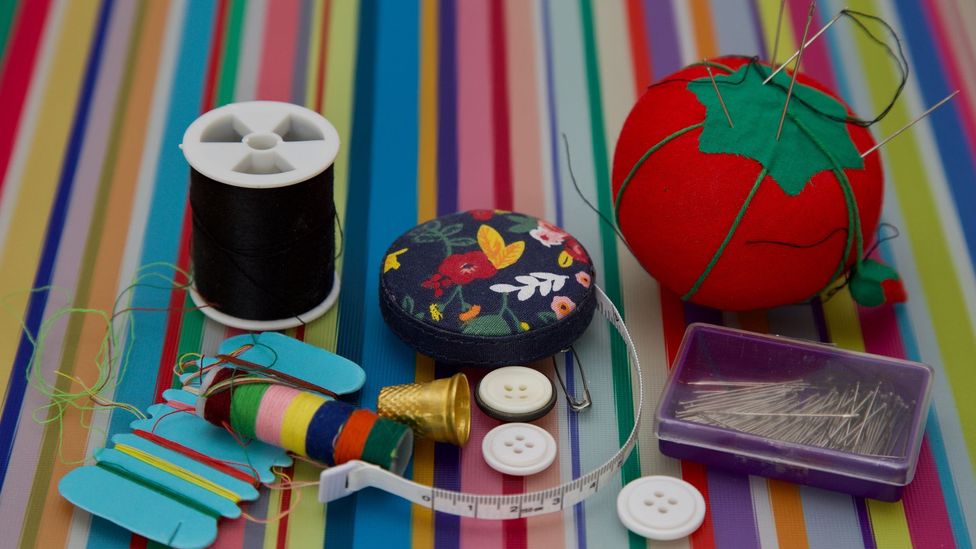
Sewing, mending and upcycling have grown in popularity in recent years, thanks in part to TV shows such as The Great British Sewing Bee (Credit: Alamy)
“Recycling and reusing clothing has been commonplace throughout time,” Tobin tells BBC Culture. “This exhibition asks: can we re-learn these skills, and apply them to our own wardrobes, to extend the life of our clothes?” Alongside precious vintage garments, including an embroidered silk parachute nightdress from 1944 when clothing and materials were rationed, 12 contemporary pieces show that modern repair is alive and kicking.
The present-day exhibits were chosen with specific ideas in mind. “We chose UK brands who are makers or who offer a return and repair service or who are sharing skills; examples of contemporary clothing made by people who are passionate about keeping clothes out of landfill,” says Tobin. Labels include Community Clothing, the British-based social enterprise set up by Patrick Grant, designer and presenter of TV sewing competition The Great British Sewing Bee, as well as ELV Denim, Reworked 348, upcycled Christopher Raeburn, knitwear designer Flora Collingwood-Norris and José Hendo, a Ugandan British designer who works with sustainable barkcloth. “The contemporary exhibits show just some of the ways that designers today re-fashion surplus stock,” says Tobin. Here, we can get some guidance from repairers through the centuries.
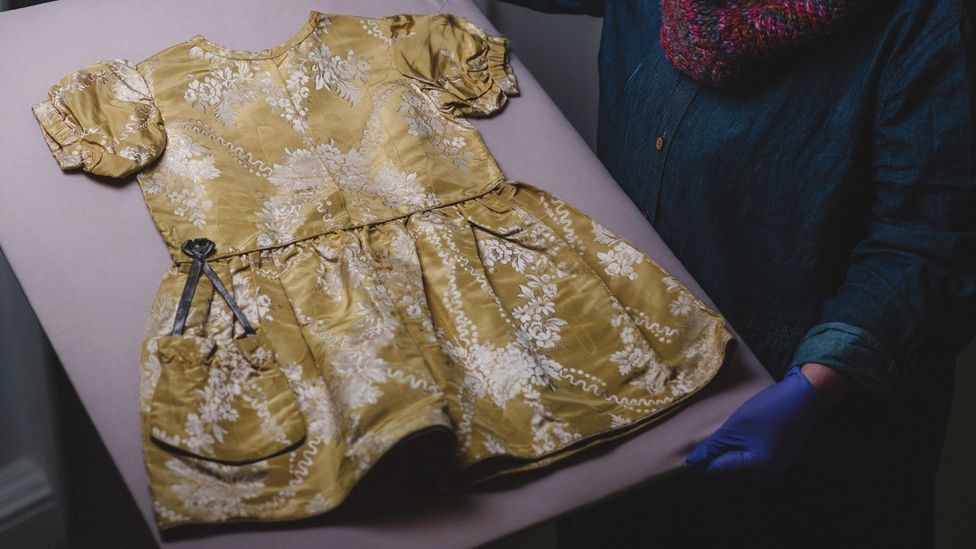
Included in the Thirsty for Fashion exhibition at the National Trust’s Killerton is a child’s party dress, re-modelled from an 1890 gown (Credit: National Trust/ Steve Haywood)
1. Re-model old pieces
A single item of clothing can be used, over and over again, in different ways and for different people. Highlights in the exhibition include a child’s dress, recycled from an adult’s precious silk brocade gown in about 1750, as well as a stunning dress in floral silk brocade from the 1770s, remodelled when those types of brocade became popular again. “Women were looking in their grandmother’s trunk or hunting in attics, and finding these dresses which had been preserved for a generation or more – and then taking them to their dressmakers to be remodelled into 1840s fashionable style,” says Tobin.
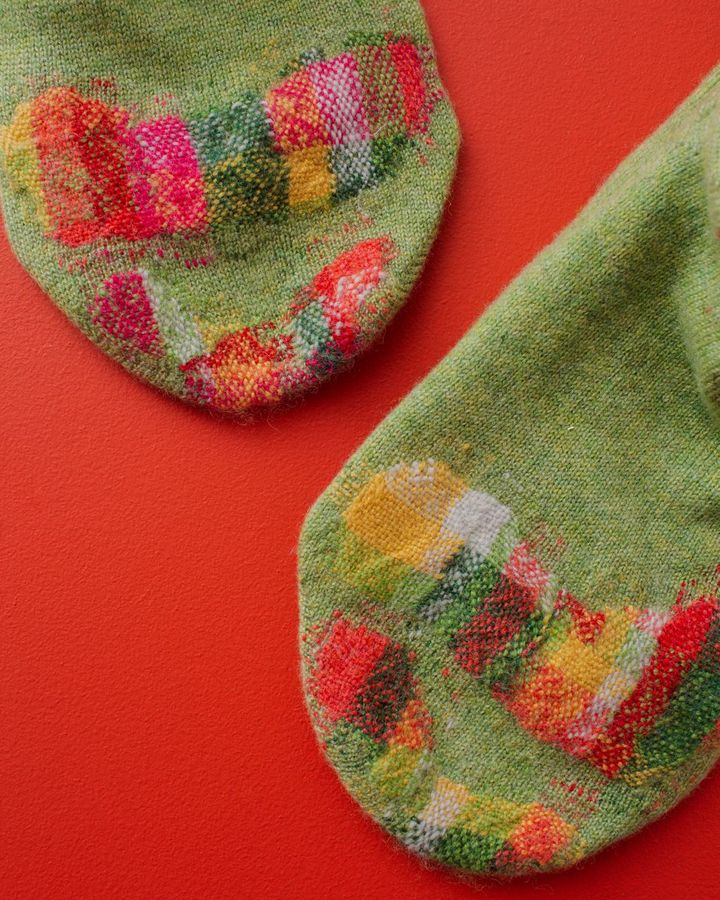
Flora Collingwood-Norris makes a feature of her visible repairs, and celebrates “the life the garment has had” (Credit: Rose + Julien Ltd)
2. Darn and mend – and make a feature of it
“You kept your clothing for as long as possible, because textiles were expensive, and people didn’t have access to lots of new things,” reflects Tobin. “And people had the skills; they’d learnt them from families or carers or at school.” Amongst carefully darned stockings, darning tools and a quilt repaired with denim, Thirsty for Fashion displays the work of Collingwood-Norris, a passionate advocate for visible mending. “By making a feature of visible repairs, we celebrate the life the garment has had, and make the process of mending more creative and fun,” Collingwood-Norris tells BBC Culture. “It becomes a statement to be worn with pride.”
3. Pass down precious clothing
For the section of the exhibition titled Oldest Thing in Your Wardrobe, Tobin invited members of the community to bring in items that they had worn for a long time and that they continue to wear. Local resident and Killerton bookshop volunteer Kim Collins offered her beautiful Afghan dress, bought in 1974 (her first, purchased with money that she’d saved), worn to Glastonbury festival and through her pregnancies – and now, having been repatched and mended dozens of times, has been passed on to her daughter Elizabeth. “It obviously has a lot of significance for her, as well as being a lovely dress she didn’t want to throw away,” says Tobin. The oldest item in the section? A military greatcoat from World War Two, often worn by Tobin’s son’s friend during historical re-enactments. “There weren’t just practical reasons for hanging on to things; the emotional connections really shone through,” she says.
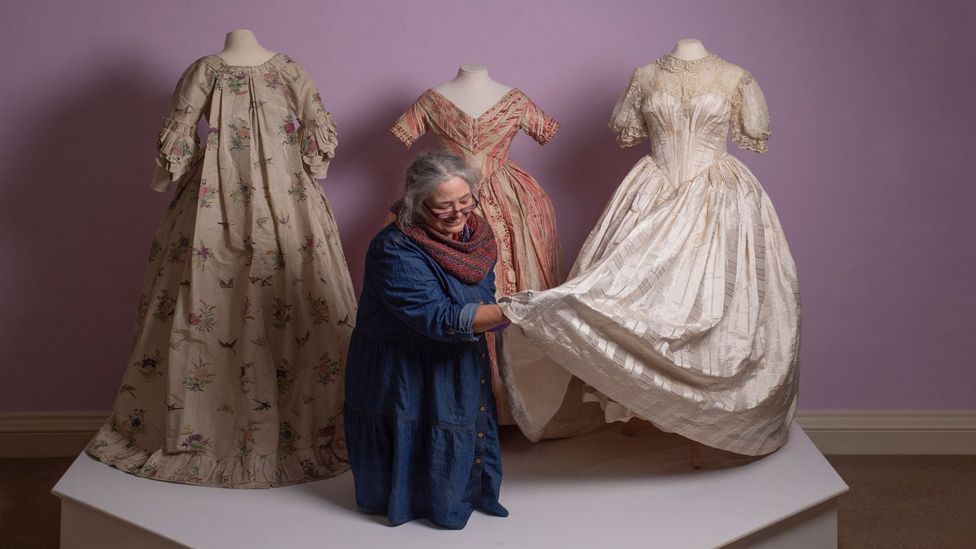
Curator Shelley Tobin with 18th and 19th-Century gowns that have been created by re-purposing precious silk fabrics (Credit: National Trust/ Steve Haywood)
4. Be creative with how you wear what you have
Another of the exhibition’s key pieces is an 1870s “transformation dress”, a billowing, lush pink, full-length silk gown that could be matched with a modest long-sleeved bodice for daytime wear or a low neck, lace-trimmed bodice for evening. The gown’s contemporary counterpart comes in the form of a stunning sculptural piece by Hendo, in dyed barkcloth and recycled silk, that can be worn as a skirt or as a dress with a halter-neck back.
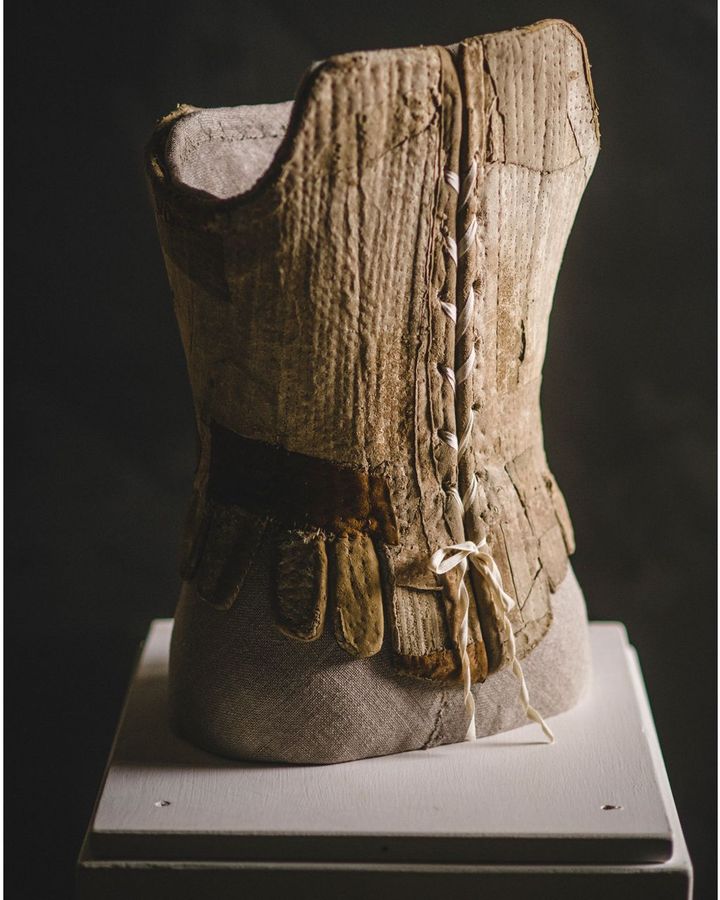
Leather stays, first made in the mid 18th-Century, have been mended and patched over in subsequent decades to prolong their life (Credit: National Trust/ Steve Haywood)
5. Use scraps inventively
Directly inspired by the transformation challenge in The Great British Sewing Bee, where contestants are asked to turn fabric scraps into colourful garments, a section titled Re-Invent at Killerton invites visitors to do the same. The exhibition’s designer produced drawings of garments that had been taken apart at the seams; visitors can then mix and match segments to create something new. “We want to get across the idea that you can make more things from one original garment,” says Tobin. Also on display is an example of a Victorian patchwork made from silks, velvets and embroidery. “There’s lots of interest in patchwork and quilting at the moment,” says Tobin. “Even if you can’t remake [scraps] into a garment, you can use those pieces to make something beautiful and useful to cover your bed.”
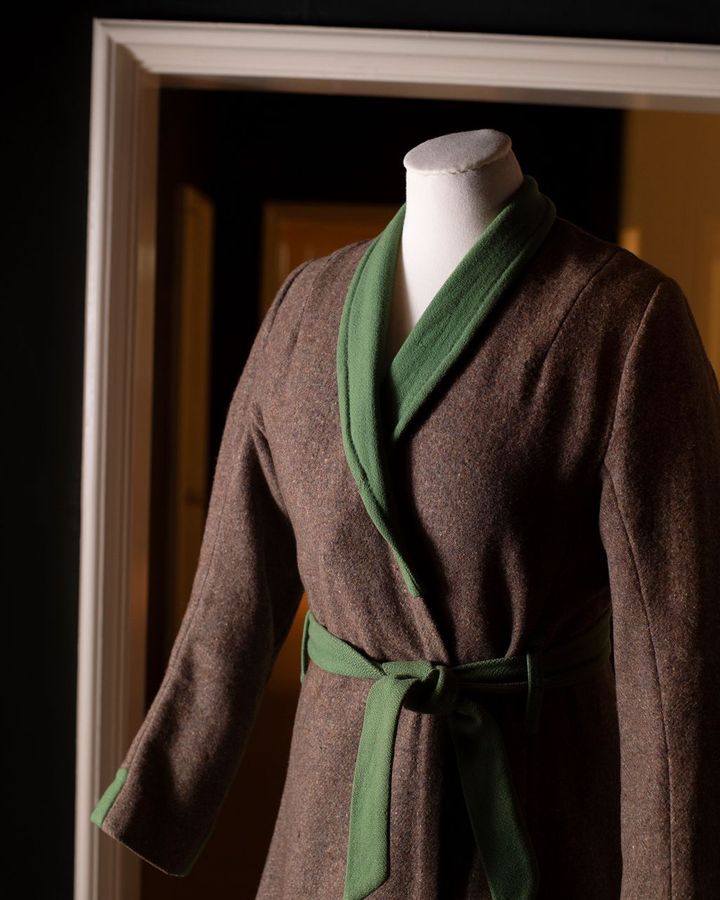
A woman’s dressing gown made in the 1940s from a surplus World War Two army blanket and repurposed green woollen cloth (Credit: National Trust/ Steve Haywood)
6. Make clothes from unexpected materials
During World War Two, materials were carefully rationed, inspiring the government at the time to set up its famous Make Do and Mend campaigns, with lively posters and films, some of which are shown at Killerton. Parachutes – constructed rather luxuriously of silk until it was replaced by nylon in 1943 – were particularly sought after. “I’ve been told that, if a pilot came down and landed in a tree during the war, they’d go off and leave their parachute behind. Then, local people would go out, retrieve the parachute, and use the non-damaged parts,” says Tobin. “My grandmother told me you could get parachutes on the black market; I’ve seen small ads in newspapers of the time, giving notice that a consignment had come in and would be on sale.”
“Once you’d got your hands on a parachute, you had the raw materials to create lingerie, cami knickers, baby clothes, even wedding dresses,” she continues. Patterns sold in shops showed how to make best use of the parachute’s elongated triangular panels. Alongside the traditional pieces, a dress by London designer Christopher Raeburn, made from silk maps given to Royal Air Force crewmen in World War Two and beyond into the Cold War, takes pride of place – as does one of Tobin’s personal favourites, an elegantly styled dressing gown, made from an army blanket.
“I’ve just been waiting for the right moment to show it,” she says. “It was made by a young woman in the 1940s in Exeter who repurposed a heavy brown blanket, and added some slightly worn green blanket wool to extend the length and to create a shawl collar. I hope this is the one piece that will inspire people to repurpose things you might not necessarily think of as clothing material. I’ve been eyeing up my son’s old duvet cover to make a dress,” she laughs. “Just because it didn’t start life as a dress fabric, doesn’t mean you can’t make a dress out of it.”
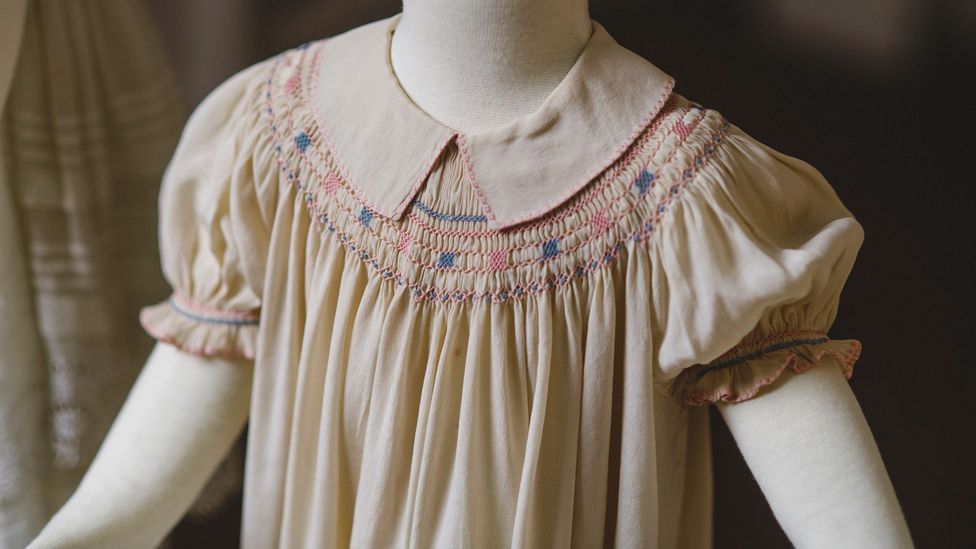
Smocking, seen here on a child’s dress from around 1885-90, means that clothing can expand as the wearer grows (Credit: National Trust/ Steve Haywood)
7. Make to grow into
“Techniques such as invisible mending, pin tucks and smocking were applied to children’s clothes,” says Tobin. Pin tucks in the hem of a skirt meant that, as the child grew in height, the skirt could be let out; as they grew in breadth, smocking across the chest could be adjusted. Sewing samplers – pieces of cloth featuring patterns and stitches that the owner may have learned or copied from others, to recreate again in new pieces, and often pieces of art in themselves – are displayed to show “the sorts of things that people were taught at school in the past, how to patch invisible mending, how to do pin tucks, how to do smocking,” says Tobin. “We only need to look to history to discover ways to ensure that the clothing we buy, make and wear is durable, ethical and avoids waste.”
8. Take care of what you have
At Killerton, visitors can watch wartime films produced by the Ministry of Information on taking care of clothing. “Don’t throw your coat on the chair the cat sleeps on; don’t put your wet shoes in front of the fire so that they dry out and lose their shape: it was that sort of thing,” reflects Tobin. “The advice was to look after your clothes carefully, and to learn how to clean and mend them. It was also about choosing well.” To illustrate this, Killerton purchased a Breton shirt and a striped top from Grant’s label Community Clothing. “They’re classics that will not go out of date and which you can wear for years – provided you take care of them.”
Thirsty for Fashion – Reused, Recycled, Reborn is at Killerton, Exeter, UK until 5 November 2023.
If you would like to comment on this story or anything else you have seen on BBC Culture, head over to our Facebook page or message us on Twitter.
And if you liked this story, sign up for the weekly bbc.com features newsletter, called The Essential List. A handpicked selection of stories from BBC Future, Culture, Worklife and Travel, delivered to your inbox every Friday.








